16 April 2002
Printer Friendly Version
The Dow Industrials fell through the second of several key supports that still lay ahead, and bulls spent the rest of Monday clawing their way back up over that level. By Tuesday, they were able to inspire a 200 point comeback in the Dow. There's lots going on there, and I'm sure the bulls and bears will hammer out the fine details in no time. But today we're going to take you through an overview of the major currency markets, specifically, what the market in each currency has been up to, both technically and otherwise.
Technically, you may regard each support level as that place on the chart where many buyers and sellers have met before. Accordingly, their importance is ranked in terms of volume as well. Support and resistance points also have implications in trend theory, depending on their sequence and what happens in between.
As we walk you through each of the major currencies, try studying the price and volume relationships for any patterns or rhythm. In particular, observe how volumes change while prices are making higher highs and higher lows, or lower highs and lower lows. There's nothing I'd like to specifically point out. Consider it an exercise in reading the tape, and see if you can deduce anything about the future by examining how these relationships change through time.
Keep in mind that while we're studying them we already have thousands of charts like these filed away in our long term memory. So for instance, I can look at the first chart of the US dollar above and observe that the peak in the dollar during February coincided with the beginning of a Dow bull charge, driven by the prospects for war in the M.E. and trade protection for certain US industries. Thus, this could help explain why the decline in the dollar on Tuesday turned out to be a bullish factor for the Dow, at least for some of the cyclicals.
Anyhow, since the February peak in the dollar, several currencies have been building (chart) arguments for a reversal against the dollar, Gold making the strongest case of them all. In the longer view, we already know that 2001 was the first year since 1994 that gold prices out performed the dollar. A glance at the long term chart of the dollar index (trade weighted) will reveal that momentum has been tiring since late 2000. Or we could say that the dollar has become a choppy trader.
Indeed, it has, and we interpret that as a transition behavior. When will the market stop being choppy? When it knows which way it wants to go. To help us figure that out, let's consider what's happening in some of the other currencies.
Europe's fundamentals actually haven't been too bad, when measured by aggregates and compared with those of the US, and Canada.
If anything, their perkier prices argue for higher interest rates and a stronger euro, while their current account surplus argues also for a strong euro. The "Euro's" fundamentals, on the other hand, are a different thing altogether. The new currency hasn't had a lot of time to garner long term confidence. There are political hurdles too. The currency probably carries a higher risk premium and is thus a heavy burden on monetary policymakers. Yet, all the more reason those policymakers need to ensure a strong euro exchange rate. The fundamentals for the Pound and Swiss Franc are different in that respect, and perhaps in terms of any assumptions about economic activity between the euro area and Britain, or Switzerland as well.
Note, in the charts to the right, how the action of the market influences the moving average (red line). I consider it important when the activity begins to bend this statistic in one direction or another.
This way we could say that a move is more significant when it begins to affect the moving average. Its significance would vary according to the parameters selected. We're using the 200 day moving average, which is a very fair measure of intermediate (medium term) winds. All of the European currencies have generally been trending up in a 2-month sequence of higher highs and higher lows, which is coincident with the peak in the Dollar index, naturally. For the Euro, the resistance level that controls the bigger picture seven month downtrend against the dollar is near $0.90, which is basically the highest level on these daily charts. In fact, in all of the European currencies, the highest high on the whole chart to the left, made in early November, represents the respective resistance points, which control their downtrends.
I do not regard a price move through the moving average as significant (beyond a five minute trade), but I do have a few rules of thumb (proprietary of course).
In the Swiss Franc, for instance, its ability to stay above the moving average is only significant if it can put in another higher high, and even more significant if it can break through 0.62, November's high.
Over the past few weeks, the Pound has been the sharpest performing European currency. I can confirm this with my own read of the daily tape. It's been trading with some conviction recently. The Bank of England has been prepping the market for an interest rate hike, something that only the Bank of Canada has done so far among the countries whose currencies we're looking at. The Canadian dollar has one of the worst looking long term charts of the bunch, in my opinion, and indeed it has been trading weaker than most of its peers, including the Australian dollar, and despite stronger commodities markets.
I don't believe that a quarter percentage point increase in the bank rate is going to be enough medicine to cure the CAD's long run technical and fundamental problems. But what do I know. The Reserve Bank of Australia was supposed to raise interest rates, but also has been timid in making a decision. Indeed, all of the main central banks are faced with the same dilemma on interest rates that the Fed is today. Only, not all of them have a current account deficit the size of the US, and none of them issue what could be considered a reserve currency except for the Fed. The question investors need to ask is how will these currencies all trade on a global interest rate rise, and will they be affected by which banks will raise rates next?
The Yen has had the worst six months of them all. Note how far prices moved from the moving average on the way down. Indeed, on the one hand, that could be a contrarian indicator, but on the other hand, prices have yet to exert a bullish influence on the moving average. Still, on a purely technical basis, the price and volume behavior of the yen is the most bullish since February's peak in the dollar.
The bullish factor there for the yen is whether the Nikkei and yen can rise in unison, which depends largely on a recovery in the beleaguered banking sector. Don't discount that. Bank shares have been doing well over there, maybe after having already discounted the worst over the past ten years or so. Besides, the government has all but said it wants to inflate the stock market, which unlike the Dow, is near 15 year lows (perhaps an easier task?).
Banking troubles aside, there is no other country in the world with as much in savings overseas, particularly in relation to foreign investment in their own country, as Japan. The payments system favors a strong yen, or at least it has generally for almost twenty years. In our view, it's the last year that has been the anomaly in the yen. Paradoxically (not really but yes if you listen to mainstreet today), the more dire the private banking structure in Japan becomes, the more pressure there will be for them to liquidate their overseas investments, called a repatriation of capital, or profits. The strong Aussie and strong Yen, however, are short term bearish factors for gold, at least until the fall in the dollar becomes precipitous and provokes fresh investment demand for gold.
Most central banks are probably rightly concerned about undermining the value of their largest currency reserve, by being the first to raise interest rates. Or maybe they feel that the US dollar is due to fall, and hope to benefit from the resultant reduced pressure by the market on them to raise interest rates. The point is the investor must assume not only that monetary policy affects currency relationships, but also that currency relationships (their activity and outlook for them) affect monetary policy.
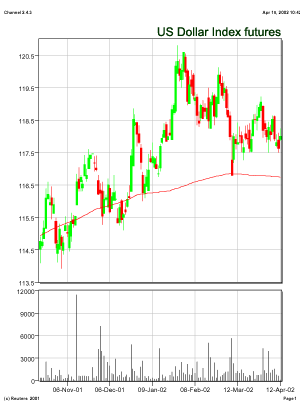
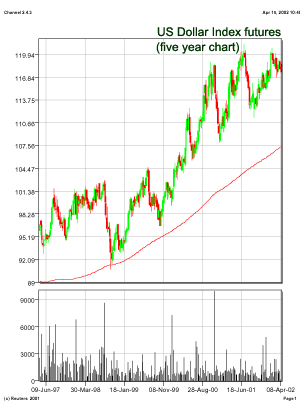

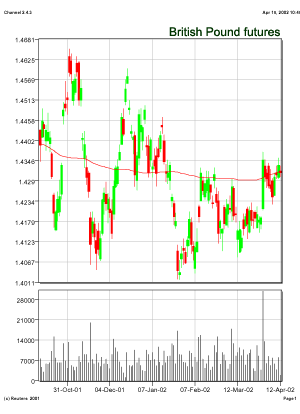
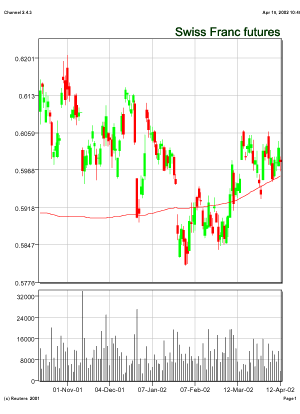
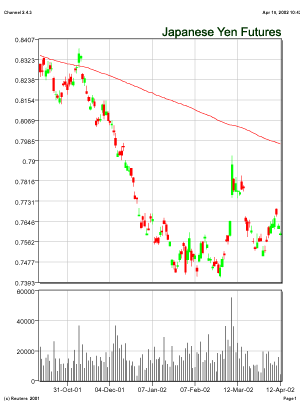


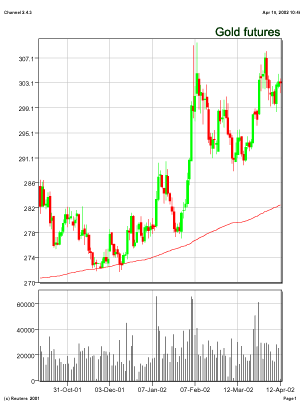
As far as the dollar goes, we see rising stock prices and rising yields together as bullish for the dollar. But the rising yields are bearish for stock prices, at the moment, and the dollar and stock market are probably better correlated these days than the dollar and yields. The dwindling US budget surplus is neutral in terms of the currency, at the moment, because all of the global governments have the same problem. However, the widening current account deficit is unsustainable, and probably the US' biggest problem, a problem that its unfriendly trade and foreign policies can quickly fix, to the detriment of the dollar.
On the other hand, many industries, both here and abroad, rely on the strong dollar to stay strong. Even the central banks of the G7 are only as strong as their foreign currency reserves. So everyone has a stake in the US dollar to some extent, which is the sole remaining bullish factor propping up the over owned and over printed currency.
To the extent that a falling US dollar allows foreign central banks the luxury to keep their own monetary policy loose, the risk of a correction in the value of the dollar is overdue anyway. But the risk is to allow the dollar to devalue such that it brings into question the validity of other "vehicle" currencies. There is one hedge against that risk:
Gold.
Ed
Bugos
Editor of The Goldenbar Report